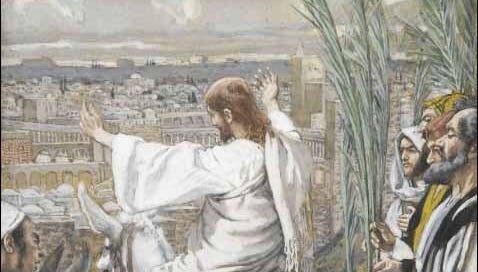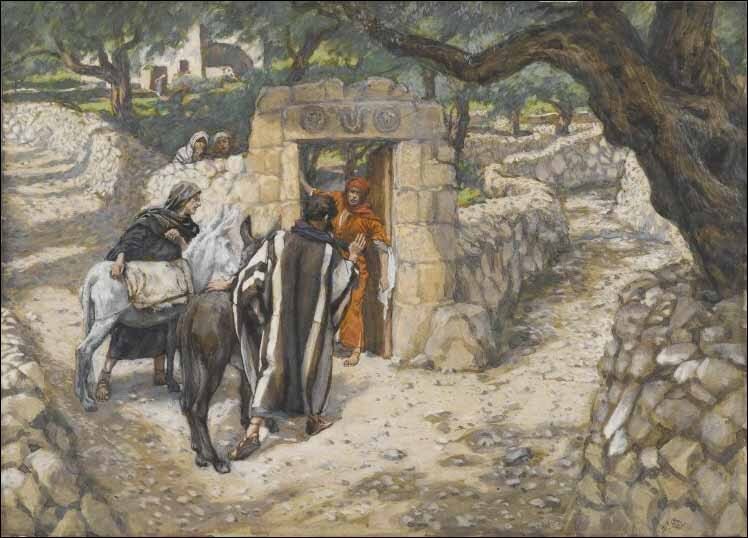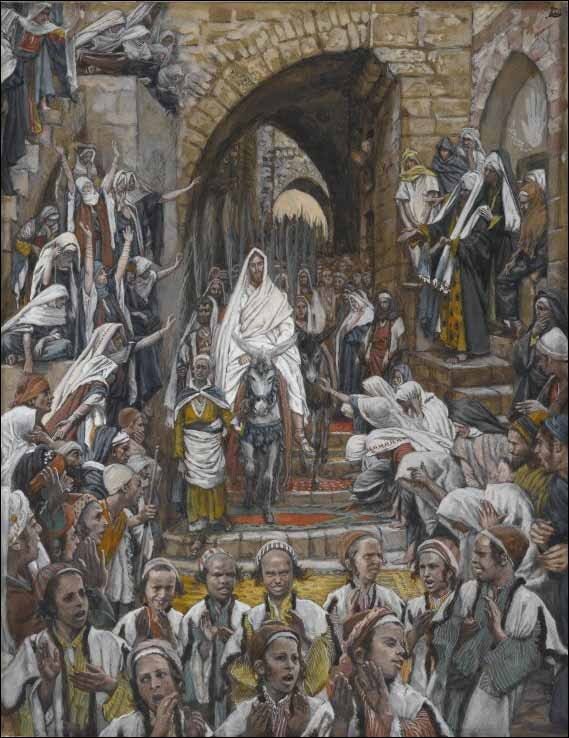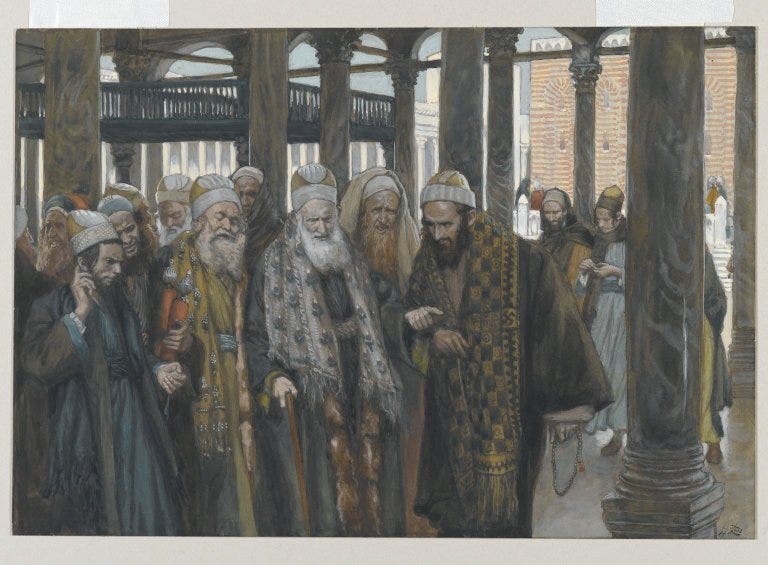Palm Sunday
Illustrated with Commentary by James Tissot and Relevant Verses from the New Testament
The Foal of Bethphage
Saint Matthew 21:1-7:
AND when they drew nigh unto Jerusalem, and were come to Bethphage, unto the mount of Olives, then sent Jesus two disciples,
Saying unto them. Go into the village over against you, and straightway ye shall find an ass tied, and a colt with her : loose them^d-nd bring fhem unto me.
And if any man say ought unto you, ye shall say. The Lord hath need of them ; and straightway he will send them.
All this was done, that it might be fulfilled which was spoken by the prophet, saying, Tell ye the daughter of Sion, Behold, thy King cometh unto thee, meek, and sitting upon an as, and a colt the foal of an ass.
Saint Mark 11:4-7
And thev went their way, and found the colt tied by the door without in a place where two ways met ; and they loose him.
And certain of them that stood there said unto them, What do ye, loosing the colt?
And they said unto them even as Jesus had commanded : and they let them go.
And they brought the colt to Jesus, and cast their garments on him; and he sat upon him.
Tissot’s Commentary
To indicate Bethphage, the Latin text of Saint Matthew uses the word castellum, which would imply a village with its castle or tower of defence. In fact, the sanctuary of Bethphage, which has now been identified as marking the spot where Jesus mounted the colt, is situated at the base of a mount, the summit of which is covered with very numerous fragments of pottery, a characteristic peculiarity of sites formerly inhabited. Moreover, this lofty spot above Bethany, from which can be seen the declivities sloping down to the Dead Sea, with the valley leading to Herodium and to Bethlehem, with all the districts on the south of Jerusalem, must, in virtue of its remarkable position, have constituted an important strategic point. It must, in fact, have been a stronghold of war; hence the choice of the name of castellum to designate the village of Bethphage.
We are completely in the dark as to which disciples were chosen to go and fetch the ass and her foal to Bethphage: all manner of conjectures have been hazarded. but not one with any foundation in fact. All we know is that the Master's instructions with regard to them were very precise; He was anxious to spare His messengers all difficulty, and told them what they were to answer in the very probable event of the owner of the two animals protesting against their being taken. ''Say ye that the Lord hath need of them,” words which very clearly indicate the character Jesus intended to give to His triumphal entrance into ferusalem. He is the Lord Who has a right of ownership in all the possessions of man and He exercises this right with discretion.
It is noteworthy that on comparing the text of the various Evangelists, we find three of them, Saint Mark, Saint Luke and Saint John, speaking of a colt only whilst Saint Matthew mentions both an ass and a colt. The words of Saint Luke, however, in chap. 79, verse 30, put us on the track of a perfectly natural explanation. The colt had never yet been mounted, and, therefore, there might be some fear that it could be restive, so they took its mother with it. Still, Saint Matthew certainly expresses himself rather strangely in this matter, for he says : «And (they) brought the ass and the colt and put on them their clothes and they set him thereon.» on which of the two does Saint Matthew mean that the Lord was set? Are their clothes on one of the two animals, or first on one and then on the other? After what we have just said, the latter hypothesis is not tenable, but, then, why should the garments have been put on both? And, moreover, what a singular mode of expression is that of Saint Matthew! Strauss thinks it a good opportunity for holding the Evangelist up to ridicule, claiming that he made Jesus Christ ride on two animals at once, whereas the difficulty is really of the slightest, admitting of three or four quite acceptable explanations.
The Procession on the Mount of Olives
St. Luke 19:37-40
AND when he was come nigh, even now at the descent of the Mount of Olives, the whole multitude of the disciples began to rejoice and praise God with a loud voice for all the mighty works that they had seen;
Saying, Blessed be the King that cometh in the name of the Lord: peace in heaven, and glory in the highest.
And some of the Pharisees from among the multitude said unto him. Master, rebuke thy disciples.
And he answered and said unto them, I tell you that, if these should hold their peace, the stones would immediately cry out.
Saint Matthew 21:8
And a very great multitude spread their garments in the way; others cut down branches from the trees, and strewed them in the way.
Jesus Wept
Saint Luke 19:41-44
AND when he was come near, he beheld the city, and wept over it,
Saying, If thou hadst known, even thou, at least in this thy day, the things which belong unto thy peace! but now they are hid from thine eyes.'
For the days shall come upon thee, that thine enemies shall cast a trench about thee, and compass thee round, and keep thee in on every side,
And shall lay thee even with the ground and thy children within thee; and thev shall not leave in thee one stone upon another; because thou knewest not the time of thy visitation.
Procession in the Streets of Jerusalem
Matthew 21:10-11
AND when he was come into Jerusalem, all the city was moved, saying. Who is this ?
And the multitude said, This is Jesus the prophet of Nazareth of Galilee.
Tissot Commentary
The streets of Jerusalem are nearly all steep, being built along the flanks of the four hills on which the town is situated. These hills have been worked as quarries from the very earliest times, first for the construction of the Temple and then for the walls surrounding the suburbs round about Mount Sion and Mount Moriah. For the various palaces erected between the time of David and that of Herod, which were built with great lavishness of material, these same quarries were drawn upon, so that beneath the courts of the Temple, and, indeed, under the whole of the town of Jerusalem, are vast subterranean spaces, which may be said to bear a distant resemblance to the catacombs of Paris. All these underground vaults and passages were utilized in times of war and also during the risings so frequent at Jerusalem during the latter days.
At the present day the only caves that can be identified are those known as the Tombs of the Kings, the entrance to which is near the Gate of Damascus: but that the other quarters of the town also had their subterranean grottoes has been abundantly proved in the course of the excavations necessitated by all the rebuilding which has been going on.
The Mishna tells us that Jewish women retired to caves beneath the Temple for the birth of their children, and that the little ones born in them were brought up in these retreats until they were seven, or, according to other accounts, even thirteen years old.
The custom had originated in memory of the Captivity in Egypt, during the beginning of which the women of Israel used to withdraw for their confinement to the Desert, in the hope of saving their offspring from death; but the Egyptians having noticed this, the mothers resorted to hiding their babies in subterranean refuges. In commemoration of this fact, and of the wonderful way in which the children thus hiddcn throve under the direct protection of God, it became usual to dedicate a certain number of the boys, brought up as described above, to the service of (he Temple. They appeared at the various ceremonies, contributing by their presence to the eclat of the services.
The soil of Jerusalem is at the present time far loftier than it was in former days, and the reason is not far to seek. Ever since its early days as a stronghold of the Jebusites that is to say for some three thousand years, materials of every description, with the necessary provisions of all manner of kinds for its inhabitants, have been pouring in whilst nothing has ever been taken out again, with the result that perfect mountains of filth and rubbish have been piled up here and there, serving as a foundation for the later buildings. These hills grew, in fact, to such a height, especially after the sieges and sackings to which the Holy City was subjected, that they are now loftier than the walls, and, on the side known as the Jewish quarter, they project beyond it and eject their surplus rubbish upon the slopes of Ophel.
The Multitude in the Temple
THE CHILDREN CRYING HOSANNA!
St. Matthew 21:14-16
AND Jesus went into the temple of God,
And when the chief priests and scribes saw the wonderful things that he did, and the children crying in the temple, and saying, Hosanna to the son of David ; they were sore displeased,
And said unto him, Hearest thou what these say? And Jesus saith unto them, Yea; have ye never read, Out of the mouth of babes and sucklings thou hast perfected praise?
Tissot Commentary
The Temple was entered from the right and worshippers went out again on the left. The orientation of the Temple being front west to east, the right half of it was on the south and the left on the north. It was, therefore, possible to go in by the door at the northwest angle and leave again by thiat on the north-east corner, after having gone twice round the Temple. To reach it from the town, therefore, Jesus must necessarily have passed over the so-catted Xystus Bridge on to which opened the Royal Porch on the south of the Temple. This Porch or gallery, which had recently been completed by Herod, consisted of five naves formed by four rows of Corinthian columns; there were one hundred and sixty of these columns, and in the centre, to uphold the cupola, were four thicker columns which four men together were scarcely able to encircle with their arms. This part of the Temple was shady throughout the day, and was, therefore, much resorted to by the people; the Pharisees preferred it as did the Sadducees and other sects, each of which had its doctors and its preachers who drew around them a crowd of adepts. It was. moreover, a convenient spot for watching what was going on in the Court of the Gentiles, a considerable portion of which is situated between the Royal Porch and the balustrade of the Chel, or the little rampart, already described, surrounding, as we have explained, the buildings of the actual Temple. Here might be seen this or that celebrity, this or that fashionable doctor or teacher surrounded by his disciples, the crowd of lookers-on gathering wherever the interest of the moment happened to be concentrated.
The Porch most frequented after that called by the Greeks the Naos Basilica was the one named after Solomon, for which Jesus seemed to have a special affection. It was situated, as is well known, on the east of the Temple in front of the Nicanor Gate: it had two rows of columns, so that there was some shade to be fou)id in it, especially in the morning until noon. It would, therefore, be in these two portions of the sacred building that the crowds would gather: the children brought up and employed in the Temple would join them and the multitude would be swelled by all the strangers who came to admire the new buildings and to worship in them in accordance with the requirements of the law.
The Chief Priests Take Counsel Together
TO DESTROY JESUS
St. Mark 11:18
AND the scribes and chief priests heard it, and sought how they might destroy him : for they feared him, because all the people was astonished at his doctrine.
Tissot Commentary
The triumphal procession had passed by, quiet had been restored to the Royal Porch, for the crowd had gone after Jesus, and none were left but a few groups of the usual frequenters of the colonnades, such as the doctors and their attendants of various sects, amongst whom Pharisees predominated. It was easy enough for them to convince themselves of the growing importance of the Nazarene, for tidings, and, indeed, fresh sounds of excitement reached them from the town and its environs every moment, confirming the signification of the events of which thev had all just been witnesses. There was no doubt that the resurrection of Lazarus had forcibly appealed to the imagination of all, kindling the hopes of everyone, so that the official authorities were beginning to find themselves at the mercy of every caprice of the new Prophet. Now, from the first He had shewn little favour to the Pharisees, and they might, therefore, well fear that He could not hesitate to make a dead set against their influence. There was. then, no time to be lost; thev must have done with this man. The secret meeting in the house of Caiaphas was known, its probable results were commented on, and what would be the best measures to take to counteract this increase of popular favour were eagerly discussed. As for Jesus Himself, all He did on that day was to pass through the Temple, which He entered from the town and left by the Susa Gate, which was later, notably in the time of the Saracens, corruptly called the Golden Gate. Then, traversing the Valley of Jehoshaphat, He was able, bv climbing obliquely the Mount of Olives, to make His wav to Bethany, where, no doubt, He lived until the following Thursday. However that may be, we shall leave Him no more, and the Gospel will give its details as numerous as they are precious on this last period of His life on earth. It will shew Him going to the Temple sometimes before daybreak, spending long hours there, and only returning home at nightfall. It will explain to us every act of His, however apparently trivial, in every hour, nay, every minute; enable us to listen to His discourses; will invite us to receive His supreme admonitions, given in the addresses which became ever more and more frequent. In a word, the Gospel will initiate us into all the mystery of those last days which were to end with the greatest event in the history of the human race.









Roseanne - what a gift you're giving the rest off us this Holy Week! And the essay on Tissot was very enlightening. May you have a blessed Holy Week and a Joyful Easter.